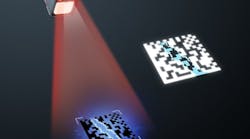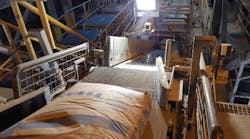How to select solid-state cameras for machine-vision applications
By Andrew Wilson, Editor at Large
Since their introduction more than 25 years ago, charge-coupled devices (CCDs) and CCD cameras have replaced tube-based cameras in nearly all machine-vision applications. Evolving from simple broadcast-compatible devices, today`s CCD cameras confront system integrators with a range of products that include time-delay-integration (TDI) based cameras for machine vision, fast-framing devices for high-speed inspection, and back-illuminated high-resolution cameras for scientific applications.
Although available CCD cameras can be broadly classified into linear, TDI, and area array devices, the types of CCDs used in them are supplied from a variety of manufacturers, including camera manufacturers. Consequently, cameras can differ markedly in terms of quantum efficiency, resolution, noise, and dark count.
Linescan cameras
From a systems integrator`s perspective, the most important consideration is which type of camera to choose. Whereas area-array cameras are useful for imaging two-dimensional scenes, linescan cameras offer high-positional accuracy, rapid frame rates, and a wide dynamic range. Manufactured with resolutions that include 128, 256, 512, 1024, 2048, 4096, and 8196 pixels per line, many of today`s linescan cameras are designed with square pixels. This characteristic is important in machine-vision systems because the system software does not have to recalibrate the image with respect to its aspect ratio.
Two linescan cameras targeting this market are the CL-CB from Dalsa (Waterloo, Ontario, Canada) and the L120-L160 series from Basler (Ahrensburg, Germany). At data rates to 20 MHz, the CL-CB camera can be supplied in resolutions of 512, 1024, and 2048 pixels per line and can supply 8-bit data at 15 or 20 MHz or 12-bit data at 10 MHz. Providing 14-µm- square pixels, CL-CB cameras can be synchronized to allow system integrators to incorporate multiple cameras into large web applications. Like the CL-CB, Basler`s L120-L160 series of linescan cameras offer resolutions of 1024 and 2048 pixels per line (see Fig. 1). Furnishing 10-µm-square pixels, these cameras can be operated at 20, 32, 40, or 62.5 MHz.
Primarily known as a supplier of imaging sensors, Thomson-CSF (Totowa, NJ) chose this year`s Applied Machine Vision Show in Nashville, TN, to introduce two linescan cameras in its TH78A13/14 series (see Fig. 2). Supplied with either a 1024- or a 2048-linear pixel array, the cameras feature 10 ¥ 10-µm pixels size and 12-bit digital or analog outputs.
Time-delay-integration cameras
In some machine-vision applications, such as web inspection, the speed of the Web might dictate the use of cameras that can integrate low-light-level images. To accommodate this requirement, system integrators often turn to a variation of the linescan image camera, known as time-delay integration (TDI).
These cameras differ from linescan sensor types because they typically use sensors with 1024 lines and a number of stages or rows of sensors positioned side-by-side in the horizontal direction. Because these sensors also incorporate rows of photoelements, they can capture multiple exposures of an object. To avoid blurring, the charge generated on each row is transferred from row to row in synchronism with the moving object.
Because TDI cameras integrate light over the vertical scanning interval while reading out lines at high scanning rates, TDI devices exhibit improved signal-to-noise ratios (S/Ns) over their linescan counterparts.
To meet the need of low-light level, high-speed imaging, several companies have developed TDI-based cameras. The EG&G LD4912/22 TDI camera, for example, uses Reticon-designed TDI devices of 1024 or 2048 elements with 32, 64, or 96 stages or rows of TDI sensors. Featuring 13-µm-square pixels, the cameras` 8-bit digital output is a linear function of the incident scene illumination. The control electronics are integrated into the camera head to drive the TDI array, read out and condition the video signals, and digitize them to 8-bits.
Two-dimensional imaging
Although linescan and TDI-based cameras prove useful in high-speed web inspection and low-light-level applications, most scientific, astronomy, machine-vision, and military image-processing applications require the capture of two-dimensional scenes. For these applications, the most common types of camera are based on frame-transfer and interline-transfer CCDs.
In frame-transfer devices, incident light is integrated into the photosites and then transferred through a shift register into a storage region covered with an opaque metal layer that blocks the charge from incident light. After the charge has been transferred from the active region, another integration period begins and the process is repeated. During integration of the subsequent frame, the charge from the first image is transferred to the output amplifier.
One important parameter of a frame-transfer CCD is the speed at which the charge can be transferred from the active region to the storage region. If not shuttered, incident light from the scene is imaged on the CCD while the charge is transferred, thereby resulting in smear.
Although available cameras may use the same technology to sense an image, companies manufacturing cameras based on this technology offer a range of products to suit a variety of markets. In the 4810 Series from Cohu (San Diego, CA), frame-transfer technology is used to allow 754 ¥ 484 images to be digitized at TV line resolutions of 565 (horizontal) ¥ 350 (vertical). As a 2/3-in. imager, these cameras output RS-170 video at 30 frames/s (see Fig. 3).
For OEMs who require better than RS-170 performance in terms of both image quality and speed, the Dalsa CA-D8-0512 single-output frame-transfer-based camera runs at 77 frames/s. For increased performance, the company`s DA-D6 frame-transfer camera integrates four 25-MHz 8-bit outputs that allow rates to 955 frames/s at 260 ¥ 260 x 8-bit resolution or 532 ¥ 516 ¥ 8-bit resolution at 262 frames/s.
Interline transfer
Like frame-transfer devices, two-dimensional interline-transfer imagers are also popular in area-scan cameras. In interline CCDs, light-sensitive pixels are located near the shielded transport region. After the charge is integrated in the light-sensitive region, the voltage potential of the transfer gate, which forms a barrier between the light-sensitive region and the storage region, is raised, and the charge from each pixel along the column is transferred into the adjacent storage pixel. The transfer gate is then lowered, and the next integration period begins.
For the interline-transfer device to function, at least half of the imager must be covered with an opaque region that reduces the effective fill factor, resulting in low quantum efficiency.
Similar to frame-transfer-based cameras, the types of cameras being built using interline CCD devices vary widely depending on the target application. The KP-D581 color CCD camera from Hitachi (Woodbury, NY), for example, has a 1/2-in. interline-transfer CCD that provides a resolution of 480 TV lines. Developed for low-light-level observations, this camera uses thermoelectric cooling to reduce the effects of dark-current noise at long exposure times.
For machine-vision, medical imaging, and industrial-inspection applications, the ES 1.0 interline CCD-based camera from Kodak (San Diego, CA) features a 1008 ¥ 1018 ¥ 8- or 10-bit resolution, 9-µm-square pixels, and a 60% fill factor. For imaging applications in areas where space is limited, the camera is also offered in a tethered-head version that provides a separate optical block connected to the main camera body by a single cable.
Like Kodak, Wintress Engineering (San Diego, CA) also targets the high-resolution machine-vision market. Using a 2/3-in., 1300 ¥ 1030-interline CCD from Sony (Montvale, NJ), Wintress` Opsis 1300AS camera uses an on-board field-programmable gate array and digital-signal processor to off-load image-processing tasks from the host personal computer (PC). For further support, the company also supplies its PCIHotLink PCI-based camera interface that can transfer up to 33 Mbytes/s to the host PC.
Charge-injection devices
Rather than use CCD technology in its cameras, Cidtec (Liverpool, NY) uses charge-injection devices (CIDs). Although CIDs have pixels constructed of metal-oxide-semiconductor capacitor integrating sites, the collected photon charge is read out in a different way. During the read operation, the collected charge remains at the pixel site and the charge remains intact for further integration or adaptive exposure control.
Benefits of CIDs include random access, radiation tolerance, nonblooming, and adaptive exposure control (see Fig. 4). However, CIDs are inherently noisier than CCDs because of the readout method used.
"We use the inherent advantages of the CID and attack those applications where antiblooming, UV sensitivity, and high-speed readout of smaller regions of interest are important," says Tony Chapman, Cidtec technical marketing manager. "For example, for Welch Allyn Medical Products (Skaneateles Falls, NY), we are building a dental-imaging module with a radiation tolerance that will give the module better picture quality and longer life than a CCD-based solution," he adds (see p. 9).
Cidtec has introduced both frame-transfer and interline-transfer cameras based on CID technology. Its CID2221D frame-transfer-based camera comes with a 256 ¥ 251 resolution and a signal-to-noise ratio of 60 dB. Providing a 60-Hz sequential frame-transfer rate, this camera contains 28-µm square pixels and on-chip windowing that allows smaller frames to be read out at higher speeds.
As an interlaced camera, the Cidtec CID3712D camera offers a 2:1 interlaced scanned 768 ¥ 612 CID array in a remote head connected to the camera via a single cable. With 11.5-mm-square pixels, a 50-dB signal-to-noise ratio, and a CCIR output, the camera provides multiple-frame integration and ultraviolet through infrared spectral response.
Active-pixel sensors
Because CCD sensors rely on specialized fabrication processes, much industry research has focused on the development of active-pixel sensors (APSs) that can be manufactured on conventional CMOS product lines. In the design of an APS device, both the photodetector and the readout amplifier are integrated at the pixel site. This integration converts the integrated charge into a voltage that can be read out using x-y wires instead of charge-domain shift registers. According to companies such as Photobit (Pasadena, CA), this integration results in lower power consumption and random readout, as well as analog-to-digital converter (ADC) and timing circuits fabricated on the chip.
"While CMOS active-pixel sensors are excellent for many low-end consumer products and video conferencing," says Eric Fossum, Photobit chief scientist, "such sensors are now challenging CCDs for many high-end applications." Photobit has debuted its PB159 200,000-element camera on a chip and is readying a 1280 ¥ 720 CMOS APS with an on-chip ADC capable of running at 60 frames/s with a 250-mW power dissipation. "Developing such imagers is one of the reasons we are Kodak`s design house for their CMOS APS program with Motorola [and now Intel]," says Fossum.
FIGURE 1. Linescan cameras are used mostly in high-speed web-inspection systems. Featuring 1024 and 2048 pixels per line, Basler`s L120-L160 series offers 10-µm-square pixels and operation at 20, 32, 40, and 62.5 MHz.
FIGURE 2. Thomson-CSF linescan cameras, the TH78A13/14 series, can be supplied with either 1024 or 2048 linear pixel arrays and provide 10 ¥ 10-µm pixels and 12-bit digital or analog outputs.
FIGURE 3. In the 4810 Series from Cohu, frame-transfer technology allows 754 ¥ 484 images to be digitized at RS-170 video rates of 30 frames/s.
FIGURE 4. Frame-transfer and interline-transfer cameras based on CID technology can be used to eliminate blooming. The radial spreading of excess charge (left) from a CCD is compared with a CID imager (right), where blooming is minimized by an underlying charge collector.
solid-state cameras-a sampling
Adaptive Optics Associates l Cambridge, MA 02140 l (617) 864-0201 l Fax: (617) 484-5549 l E-mail: [email protected] l Web: www.aoainc.com/
Adimec Advanced Image Systems l Eindhoven, The Netherlands l Fax: (31) 40-2552520
Apogee Instruments l Tucson, AZ 85716 l (520) 326-3600 * Fax: (520) 326-0880 * Web: www.apogee-ccd.com/
Atlantic International Imaging l Brookline, MA 02146 l (617) 731-3663 l Fax: (617) 731-2919 l Web: world.std.com/~atlanint
Ball Corp. l Muncie, IN 47305 l (765) 747-6100 l Fax: (765) 747-6850 l Web: www.ball.com/aerospace/vpt.html
Basler Vision Technologies l D-22926 Ahrensburg, Germany l +49 /(0) 4102 /463-0 l Fax: +49 /(0)4102 /463-109 l Web: www.baslerweb.com/
Cidtec l Liverpool, NY 13088 l (315) 451-9410 l Fax: (315) 451-9421 l E-mail: [email protected] l Web: www.cidtec.com/
Cohu Electronics Division l San Diego, CA 92123 l (619) 277-6700 l Fax: (619) 277-0221 l Web: www.cohu.com/
Cordin l Salt Lake City, UT 84119 l (801) 972-5272 l Fax: (801) 972-8270 l E-mail: [email protected] l Web: www.cordin.com/
Dage MTI l Michigan City, IN 46360 l (219) 872-5514 l Fax: 219-872-5559 l E-mail: [email protected] l Web: www.dagemti.com
Dalsa l Waterloo, Ontario, Canada N2V 2E9 l (519) 886-6000 l Fax (519) 886-8023 l Web: www.dalsa.com/
DRS l Parsippany, NJ 07054 l (973) 898-1500 l Fax: (973) 898-4730 l Web: www.drs.com/
Eastman Kodak Co. l San Diego, CA 92121 l (800) 462-4307 l Web: www.masdkodak.com/
EG&G Reticon l Wellesley, MA 02181 l (781) 237-5100 l Web: www.gifgginc.com/bin/webmate/egg/page/egg/view_division/Divisions/Opto/109
ELMO Mfg. Corp. l New Hyde Park, NY 11040 l (516) 775-3200 l Fax: (516) 775-3297 l E-mail: [email protected] l Web: www.giflmo-corp.com
Hamamatsu Photonic Systems Divisionl Bridgewater, NJ 08807-0910 l (908) 231-1116 l Fax: (908) 231-0852 l E-mail: [email protected] Web: www.hamamatsu.com
Hitachi Denshi America l Woodbury, NY 11797 l (516) 921-7200 l Fax: (516) 921-0993 l Web: www.hdal.com/
Hopkins Imaging Systems l Duarte, CA 91010 l (626) 305-8833 l Fax: (626) 305-8838 l Web: www.hopkinsimaging.com/
Ikegami Electronics l Maywood, NJ 07607 l (201) 368-9171 l Fax: (201) 569-1626 l Web: www.ikegami.com/
Interactive Technologies International l Ellenton, FL 34222 l (941) 723-3600 l Fax: 941-723-3449 l E-mail: [email protected] l Web: www.itti.com/
JC Labs l Mountain View, CA 94043 l (650) 967-3431 l Fax: (650) 967-3439 l Web: www.jclabs.com/
KSV Instruments USA l Monroe, CT 06468 l (203) 268-1745 l Fax: (203) 459-0437 l E-mail: [email protected] l Web: www.ksvltd.fi/
Life Science Resources l Melville, NY 11747 l (516) 844-5085 l Fax: (516) 844-5114 l Web: www.astrocam.com/
Micro Luminetics l Los Angeles, CA 90034 l (310) 559-2615 l Fax: (310) 836-4733 l Web: www.cryocam.com/
mikromak l D-91058 Erlangen, Germany l (49) (9131) 69096-0 l Fax: (49) (9131) 69096-18 l E-mail: [email protected] l Web: www.mikromak.com/
Motion Analysis Corp. l Santa Rosa, CA 95403 l (707) 579-6500 l Fax: (707) 526-0629 l Web: www.motionanalysis.com/
Olympus America l Melville, NY 11747 l (516) 844-5888 l Web: www.olympus.ipg.com/
Panasonic l Secaucus, NJ 07094 l (201) 348-7000 l Web: www.panasonic.com/
PCO Computer Optics l 93309 Kelheim, Germany l +49 (9441) 2005-0 l Fax: +49 (9441) 2005-20 l E-mail: [email protected] l Web: www.pco.de/
Philips Components l Slatersville, RI 02876 l (401) 762-3800 l Fax: (401)-767-4493 l Web: www.philipspcg.com/
Photobit l Pasadena, CA 91101 l (626) 683-2200 l Fax: (626) 683-2220 l Web: www.photobit.com/
Photometrics l Tucson, AZ 85706 l (520) 889-9933 l Fax: (520) 573-1944 l Web: www.photomet.com/
PixelVision l Beaverton, OR 97006 l (503) 629-3210 l Fax: (503) 629-3211 l E-mail:[email protected] l Web: www.pv-inc.com/
Precision Camera l Toronto, Ontario, Canada M4M 2S1 l (416) 461-3411 l Fax: (416) 461-4869 l E-mail: [email protected] l Web: www.pci-canada.com
Redlake l Morgan Hill, CA 95037 l (800) 453-1223 l Fax: (408) 778-6256 l Web: www.redlake.com/
Scientific Imaging Technologies l Beaverton, OR 97075 l (503) 644-0688 l Fax: 503/671-7110 l E-mail: [email protected] l Web: www.site-inc.com/
Sensors Unlimited l Princeton, NJ 08540 l (609) 520-0610 l Fax: (609) 520-0638 l E-mail: [email protected] l Web: www.sensorsinc.com/
Siemens Energy & Automation l Santa Clara, CA 95052 l 964-4114 l Web: www.sea.siemens.com/
Silicon Vision Inc. l Fremont, CA 94538 l (510)770-2300 l Fax: (510)770-2301 l Web: www.siliconvision.com
Sony Electronics l Montvale, NJ 07647 l (201) 358-4971 l Fax: (201) 358-4170 l Web: www.sony.com/
Sound Vision l Framingham, MA 01701 l (508) 270-0027 l Fax: (508) 620-7692 l Web: www.soundvisioninc.com
Thomson Components and Tubes l Totowa, NJ 07511 l (973) 812-4305 l Fax: (973) 812-4191 l Web: www.thomson-csf.com
Toshiba America Information Systems l (714) 461-4986 l Fax: (714) 470-9390 l Web: www.toshiba.com/
TVI Vision Oy l FIN-00810 Helsinki, Finland l +358-9-759 001 l Fax: +358-9-759 00 319 l Web: www.tvi.fi/
Videology Imaging Solutions l Greenville, RI 02828 l (401) 949-5332 l Fax: (401) 949-5276
Video-Optics l Los Gatos CA 95032 l (408) 378-8460
Vision l San Jose, CA 95129 l (408) 556 1550 l Fax: (408) 556 1564 l Web: www.vvl.co.uk/
Vision Research l Wayne, NJ 07470 l (973) 696-4500 l Fax: (973) 696-0560 l Web: www.visiblesolutions.com/
Visual Instrumentation l Lancaster, CA 93534 l (805) 945-7999 l Fax: (805) 723-5667 l Web: www.visinst.com/
Wintress Enginering l San Diego, CA 92121 l (800) 550-7300 l Fax: (619) 550-0373
Xybion l San Diego, CA 92126 l (619) 566-7850 l Fax: (619) 566-2032 l Web: www.xybion.com/









